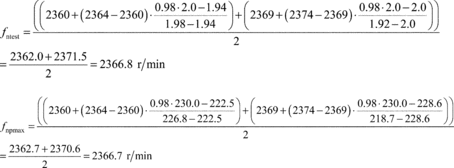§ 1065.610 Duty cycle generation.
This section describes how to generate duty cycles that are specific to your engine, based on the normalized duty cycles in the standard-setting part. During an emission test, use a duty cycle that is specific to your engine to command engine speed, torque, and power, as applicable, using an engine dynamometer and an engine operator demand. Paragraphs (a) and (b) of this section describe how to “normalize” your engine's map to determine the maximum test speed or torque for your engine. The rest of this section describes how to use these values to “denormalize” the duty cycles in the standard-setting parts, which are all published on a normalized basis. Thus, the term “normalized” in paragraphs (a) and (b) of this section refers to different values than it does in the rest of the section.
(a) Maximum test speed, ƒntest. For variable-speed engines, determine ƒntest from the torque and power maps, generated according to § 1065.510, as follows:
(1) Determine a measured value for ƒntest as follows:
(i) Determine maximum power, Pmax, from the engine map generated according to § 1065.510 and calculate the value for power equal to 98% of Pmax.
(ii) Determine the lowest and highest engine speeds corresponding to 98% of Pmax, using linear interpolation, and no extrapolation, as appropriate.
(iii) Determine the engine speed corresponding to maximum power, fnPmax, by calculating the average of the two speed values from paragraph (a)(1)(ii) of this section. If there is only one speed where power is equal to 98% of Pmax, take fnPmax as the speed at which Pmax occurs.
(iv) Transform the map into a normalized power-versus-speed map by dividing power terms by Pmax and dividing speed terms by fnPmax. Use the following equation to calculate a quantity representing the sum of squares from the normalized map:

Where:
(v) Determine the maximum value for the sum of the squares from the map and multiply that value by 0.98.
(vi) Determine the lowest and highest engine speeds corresponding to the value calculated in paragraph (a)(1)(v) of this section, using linear interpolation as appropriate. Calculate fntest as the average of these two speed values. If there is only one speed corresponding to the value calculated in paragraph (a)(1)(v) of this section, take fntest as the speed where the maximum of the sum of the squares occurs.
(vii) The following example illustrates a calculation of fntest:
Pmax = 230.0

(2) For engines with a high-speed governor that will be subject to a reference duty cycle that specifies normalized speeds greater than 100%, calculate an alternate maximum test speed, fntest,alt, as specified in this paragraph (a)(2). If fntest,alt is less than the measured maximum test speed, fntest, determined in paragraph (a)(1) of this section, replace fntest with fntest,alt. In this case, fntest,alt becomes the “maximum test speed” for that engine for all duty cycles. Note that § 1065.510 allows you to apply an optional declared maximum test speed to the final measured maximum test speed determined as an outcome of the comparison between fntest, and fntest,alt in this paragraph (a)(2). Determine fntest,alt as follows: